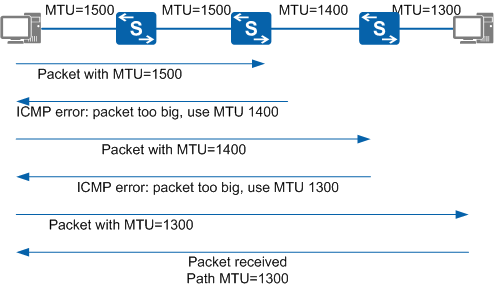Path MTU
In an IPv4 network, oversized packets need to be fragmented. When a transit device receives a packet exceeding the maximum transmission unit (MTU) size of its outbound interface from a source node, the transit device fragments the packet before forwarding it to the destination node. In an IPv6 network, however, only the source node can fragment packets, which reducing pressure on transit devices. When an interface on a transit device receives a packet whose size exceeds the MTU, the transit device discards the packet and sends an ICMPv6 Packet Too Big message to the source node. The ICMPv6 Packet Too Big message contains the MTU value of the outbound interface. The source node fragments the packet based on the MTU and resends the packet, increasing traffic overhead. The Path MTU Discovery protocol dynamically discovers the MTU value of each link on the transmission path, reducing excessive traffic overhead.
The PMTU Discovery protocol is implemented through ICMPv6 Packet Too Big messages. A source node first uses the MTU of its outbound interface as the PMTU and sends a probe packet. If a smaller PMTU exists on the transmission path, the transit device sends a Packet Too Big message to the source node. The Packet Too Big message contains the MTU value of the outbound interface on the transit device. After receiving this message, the source node changes the PMTU value to the received MTU value and sends packets based on the new MTU. This process repeats until packets are sent to the destination address. The source node obtains the PMTU of the destination address.
Figure 1 shows an example of PMTU discovery.
Packets are transmitted through four links with MTU values of 1500, 1500, 1400, and 1300 bytes. Before sending a packet, the source node fragments the packet based on a PMTU of 1500. When the packet is sent to the outbound interface with MTU 1400, the device returns a Packet Too Big message carrying MTU 1400. The source node then fragments the packet based on MTU 1400 and sends the fragmented packet again. The process repeats when the packet based on MTU 1400 is sent to the outbound interface with MTU 1300, the device returns another Packet Too Big message that carries MTU 1300. The source node receives the message and fragments the packet based on MTU 1300. In this way, the source node sends the packet to the destination address and discovers the PMTU of the transmission path.

IPv6 allows a minimum MTU of 1280 bytes. Therefore, the PMTU must be greater than 1280 bytes. PMTU of 1500 bytes is recommended.
